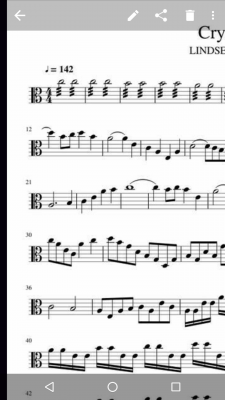Welcome to our forum. A Message To Our New and Prospective Members . Check out our Forum Rules. Lets keep this forum an enjoyable place to visit.
Currently working on errors from the latest (SimplePress) forum update. Many issues have been resoled and others are being worked on. Thank you for your patience.
 Topic RSS
Topic RSS



 (0 votes)
(0 votes) Member
 Offline
Offline










Hi @Selflearnerviolinist -
If you mean the actual first scored note, the note itself is a "B" fourth finger on E string - and the slashes through the stem indicates tremolo - check out FiddlerMan's tutorial here -
I assume it's the slashes through the stem that you're curious about ?
Tremolo can mean slightly different things on different instruments and may sometimes involve a change in pitch, alternating between two adjacent notes.
Apparently, the number of "slashes" on the note may give an indication/hint to the player as to the repetition rate, here the 3 slashes would suggest a repetition rate of a demi-semi-quaver or 1/32nd note - although I suspect it's often just interpreted as "play it as fast as possible" given other circumstances ( like bow speed, pressure ).
Having said that, await feedback from others, I'm often on the wrong track myself, but that's how I currently understand it ! LOL
EDIT : ROFL - I would have silently corrected the above but I'll say it here (proves I'm human after all - what a let-down ) - the note is NOT a "B" - hahahaha - the piece is in alto clef - hadn't noticed until I reviewed the post - it's a "C", second finger on the top A string ! Grrrrrrrrrrrrrrrrr  The rest of my comment, I'll leave unchanged. I give up.....
The rest of my comment, I'll leave unchanged. I give up..... 
I seriously recommend not copying my mistakes. D'oh -
Please make your own, different mistakes, and help us all learn :-)
Member
 Offline
OfflineBillyG said
Hi @Selflearnerviolinist -If you mean the actual first scored note, the note itself is a "B" fourth finger on E string - and the slashes through the stem indicates tremolo - check out FiddlerMan's tutorial here -
I assume it's the slashes through the stem that you're curious about ?
Tremolo can mean slightly different things on different instruments and may sometimes involve a change in pitch, alternating between two adjacent notes.
Apparently, the number of "slashes" on the note may give an indication/hint to the player as to the repetition rate, here the 3 slashes would suggest a repetition rate of a demi-semi-quaver or 1/32nd note - although I suspect it's often just interpreted as "play it as fast as possible" given other circumstances ( like bow speed, pressure ).
Having said that, await feedback from others, I'm often on the wrong track myself, but that's how I currently understand it ! LOL
EDIT : ROFL - I would have silently corrected the above but I'll say it here (proves I'm human after all - what a let-down ) - the note is NOT a "B" - hahahaha - the piece is in alto clef - hadn't noticed until I reviewed the post - it's a "C", second finger on the top A string ! Grrrrrrrrrrrrrrrrr
The rest of my comment, I'll leave unchanged. I give up.....

Hi Billy,
Thanks for your help here. It's clear now.
Quick question, how do you know it's a C not the B as i suspected.
Happy Violining!!
Regulars
 Offline
Offline

Because of the definition of an alto clef (see https://en.wikipedia.org/wiki/.....#Alto_clef). The line that the center of the figure at the front is on is C. Count up 8 notes, and you're at the note that's showing at the beginning of that piece, and since it's 8 notes, it's another C.
1 Guest(s)


 Log In
Log In Register
Register











